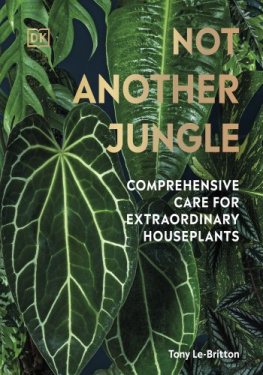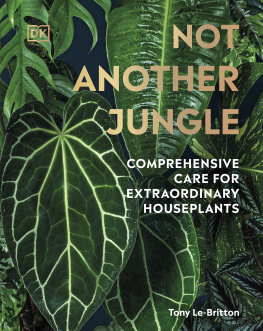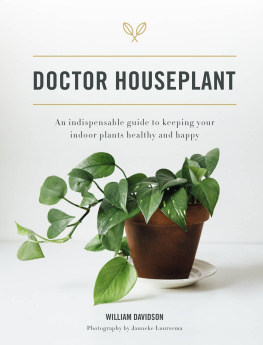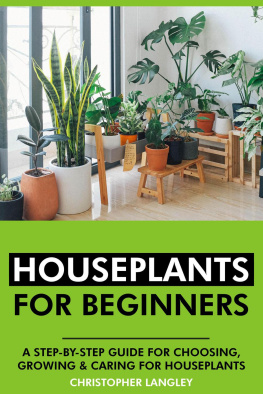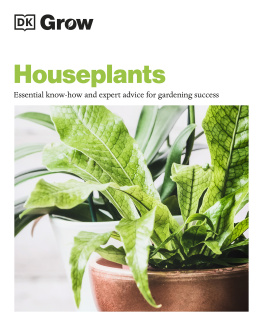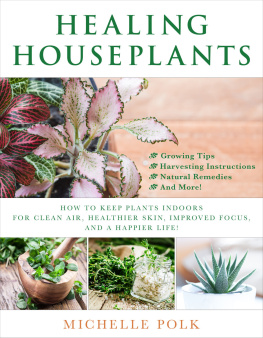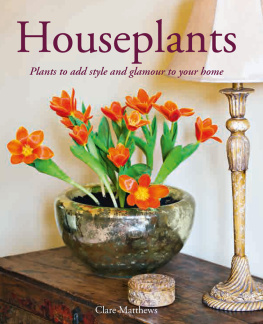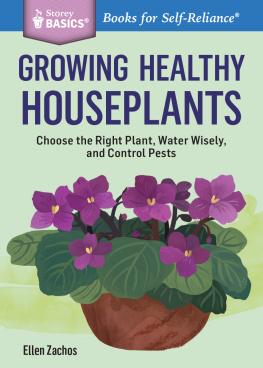g
How to use this e-book
Preferred application settings
For the best reading experience, the following application settings are recommended:
- Orientation: Portrait
- Color theme: White background
- Scrolling view: [OFF]
- Text alignment: Auto-justification [OFF] (if the e-book reader has this feature)
- Auto-hyphenation: [OFF] (if the e-book reader has this feature)
- Font style: Publisher default setting [ON] (if the e-book reader has this feature)
- In Settings, change the font size to a size you are most comfortable with.
- Double-tap images in the book to open images to full screen and to be able to zoom-in and see details clearly.
Contents
g
Houseplants and me
Plants have always played a huge part in my life. My earliest and fondest memories are of being in the garden or in our community garden. I was blessed to have spent the majority of my childhood with my grandparents, who were both keen gardeners and who inspired my love for plants and gardening. Before I could stand my nana would prop me up at the utility room bench, securing me to the back of a chair with a belt so I was firmly upright and had my hands free to sow seeds and pot plants. I was pricking out plants before I could even walk!
My nana grew most things from seed; she filled the garden with flowers all summer long and she had a beautiful collection of houseplants on the windowsill that thrived in the humidity caused by a constant flow of laundry being washed and dried around them. My grandad was a very traditional grower; he loved growing vegetables, all immaculate and in uniform, straight linesnot a weed in sight. He had a broad knowledge that he had gained over many decades from his elders and from years of trial and error.
My first collection of plants was a rockery. Most children my age (then around five) carried their toys around with them, but I had a trike with a trailer on the back that I filled with soil and rocks and planted up with little pieces of campanula, sempervivum, and sedum that Id pulled out from the cracks in the wall. It was my pride and joy, but I do have very vivid memories of the stench that came from it when it filled with water that would sit there for days. That was my earliest lesson in the importance of drainage!
In my teenage years I moved on from that trailer to collecting orchids, and I dedicated my interest to these plants until I was in my mid-twenties. For my sixteenth birthday I was allowed to pick one special orchid from Burnham Nurseries, in Devon, and I also received another Phalaenopsis to add to my collection (I still have it today, more than sixteen years later). This tiny collection grew to over 100 orchids, which filled my apartment before I had to rehome all but that one Phalaenopsis when I moved to South East Asia. Through living in Asia, and having the opportunity to explore the Galapagos Islands, Borneo, the Amazon, and the Andes, too, my love of tropical plants really took hold.
When I returned to the UK I added some more houseplants to my collection, but it wasnt until I moved into an apartment with no yard that I started to collect these rarer plants more extensively and create my own jungle garden indoors. I even sacrificed my spare room to house a walk-in greenhouse so I could grow my tropicals in optimum conditions.
In late 2021, my hobby went to another level. I was walking through my local town and spotted a run-down building that I thought would make a beautiful plant store. I wasnt looking to open a business, but then I realized this would allow me to dedicate more of my working day to doing what I love and enable me to use all of the knowledge I had accumulated to propagate and sell plants professionally.
After a long renovation, in 2022 the doors to Not Another Jungle swung wide open and people traveled from all over the UK (and even from around the world) to attend the opening. I propagate many of the plants I sell, and the ethos behind the shop and this book is to arm people with all the information they need to grow on, cultivate, and even propagate their own plants successfully. I want to make sure that enthusiasts choose a plant that is right for their specific growing conditionsmy aim is to enable everyone to be successful with houseplants. I also want to inspire them to explore plant growing and to cut down on unnecessary waste by keeping their plants going longer and rejecting the throwaway plant culture. Its a win-win.
The feeling that comes from nurturing individual living things and seeing them grow is something that cant be rivaled. Rare and unusual plants often demand more detailed care than many of those cultivated for the current houseplant market if they are to truly thrive, so for all you fellow houseplant enthusiasts out there, Im going to be your guide to caring for those plants so they achieve their full potential.
My home is filled with a variety of rare and unusual plants; caring for them and watching them thrive gives me an unrivaled enjoyment.
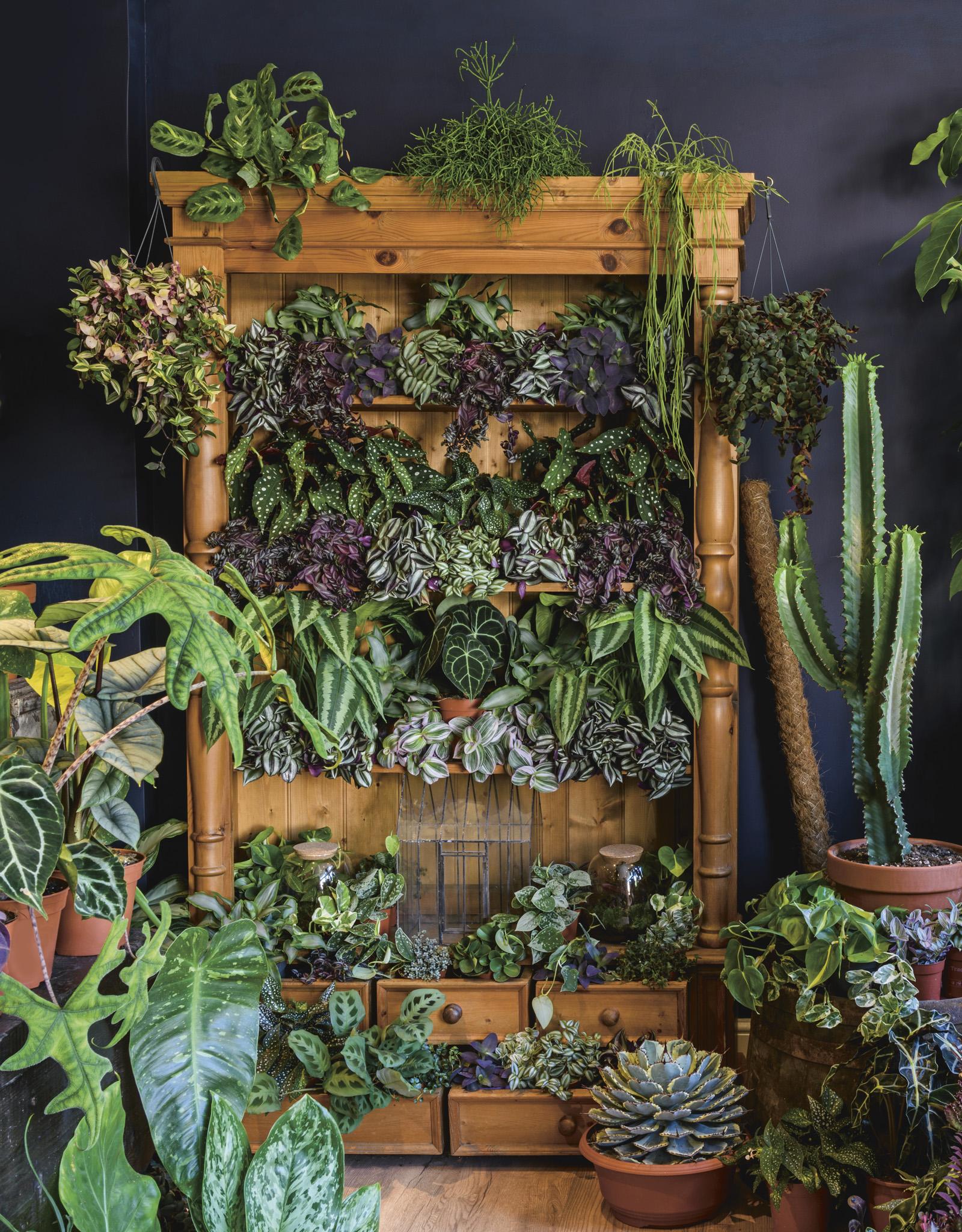
I love this riot of color, shape, and texture on a repurposed shelving unit in my shop. It looks fantastic and showcases a huge variety of large, small, climbing, and hanging plants.
g
GETTING STARTED
Getting Started | CONTENTS
g
Indoor habitats
In this book Im going to help you take your houseplant growing to the next level, by sharing my knowledge as both a home and professional grower, explaining how to care for and nurture your plants, but also the reasons behind why we do what we do for them and why plants behave in certain ways.
I love the natural world and often combine my love of travel with my passion for plants. Seeing the terrain and environment in which these plants grow in the wild, and absorbing information from the locals who have cultivated these species through generations, has armed me with essential knowledge about how they grow and what they need to thrive. That said, observing plants outside their usual habitat is also hugely beneficialwhether in unusual outdoor locations, greenhouses, or even homes. Some plants can be documented growing well in a damp spot beneath the jungle canopy, but to see them flourishing in a crack in a rock in full sun on the side of the road or along a cliffside is also fascinating.
I see influences in how I garden from both inside and outside, because growing houseplants, for me, is just gardening. Its an extension of my garden, but one that allows me to grow a wide variety of plants that I couldnt grow outdoors in the UK climate and that I can cultivate all year round, no matter what the weather.
I like to find the best spots for these plants indoors so they feel at homebut not so that they get too comfortable and take over! My current home has allowed me to have plants both inside and outside. Inside, I adapt plants to fit in with my own living environment, giving them the best care but without adding additional humidity that could damage interiors; outside is another matter, though, as they grow in a greenhouse that runs at very high humidity.
The greenhouse
My greenhouse is a little different to most. I built it inside a garage and it faces south so it can take advantage of the suns light and heat. The temperatures can get very cold here, so I have to minimize heat loss as much as I can in order to limit how much I have to artificially heat the greenhouse. To do this I have insulated the sides and roof of the building to retain heat.
Although the greenhouse is heated year-round, I drop the thermostat to 50F (10C) during the winter months, which the plants dont seem to mindthey just slow slightly in their growth. They are used to these lower temperatures, because even during summer the evening temperatures can drop to 5059F (1015C) in the UK.
Next page
